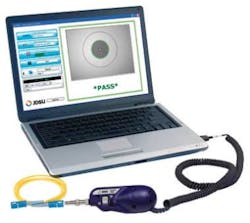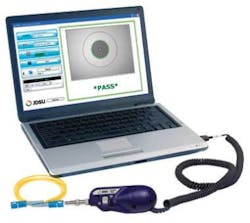Testing cabling's twists, turns and terminations
A solid combination of hardware, software and knowledge can equip technicians for tackling in-the-field testing challenges.
by Patrick McLaughlin
Technicians who perform testing of installed cabling in the field know that they never really have a complete set of test equipment. That is because the scope of network-infrastructure systems and connections that could, and in most cases should, be tested is constantly growing. Furthermore, the number and variety of testing tools available also grows. Technicians always seem to be just one customer-request away from acquiring, whether permanently or temporarily, a new piece of test equipment.
Several recent product and technology introductions in the testing realm, as well as the new availability of reference materials for testing technicians, promise to keep cabling-system professionals both up to date and busy learning the intricacies of the new tools.
Testing copper systems
Megger Networks (www.meggernetworks.com) has offered the SCT, Structured Cable Tester, series of products for some time. The product suite can test twisted-pair cabling systems up to Category 7 with a frequency range up to 1,000 MHz, the company says. It also functions as a fiber-optic tester. Earlier this year Megger introduced what it calls Virtual SCT. It is not an actual tester, but rather an online demonstration that allows users to experience the SCT2000 tester's functionality from their keyboards. SCT2000 is Megger's Category 7 test instrument. The company says the Virtual SCT highlights the tester's simplicity.
The FiberChek2 application from JDSU defines concentric areas around the fiber core and allows users to establish failure criteria by evaluating defects.
High-end copper and fiber testing capabilities have long been the domain of Fluke Networks (www.flukenetworks.com), which introduced the DTX test set in 2004. This year, in addition to rolling out some new infrastructure-testing technology, Fluke Networks has introduced reference and tutorial information aimed at helping professionals who test and troubleshoot networks' lower layers including the physical layer. Specifically, in July the company made available the second edition of the Network Maintenance and Troubleshooting Guide: Field-Tested Solutions for Everyday Problems.
When announcing the guide, the company stated, "While the evolution of technology has in some cases simplified the tools engineers use to perform their jobs, understanding the basics of networking remains a necessary and valuable skill. Engineers and technicians can turn to the guide for guidance, starting with the fundamentals of networking, running through troubleshooting and triage, moving up through performance optimization."
Debra Curtis, research vice president in the IT Operations Management group of analyst firm Gartner (www.gartner.com), added, "Basic training opportunities are not as common as they once were, so today's network engineers often lack access or exposure to the fundamental information that engineers were accustomed to a decade ago." Fluke Networks' vice president of marketing Gary Ger said the publication of the guide represents the company's "striving to offer practical information that's useful for those professionals tasked with installing, supporting, monitoring and troubleshooting today's networks and infrastructure."
Another educational effort that Fluke Networks has undertaken this year has focused on the practical procedures for conducting alien-crosstalk testing on installed Category 6A systems. The company produced a video that breaks the alien-crosstalk-testing process down into the following five steps. 1) Test each Category 6A link exactly as you would test Category 6 or Category 5e. 2) Select victim cables to test. 3) Identify disturber cables for each victim. 4) Test for alien crosstalk from the near end. 5) Test for alien crosstalk from the far end, if required.
The video shows the use of the company's LinkWare software to identify victim and disturber cables. It emphasizes that the software package can be used for this purpose at a main office once in-channel tests have been conducted, or the package can be used on a laptop at the jobsite.
Fiber at the forefront
The topic of fiber-connector integrity has been gaining attention over the past couple years as owners of fiber systems look at the practicality of their installed systems of today supporting tomorrow's extremely high-speed transmission rates. Consequently, the concept of fiber-endface cleanliness has taken on increased importance for many. And providers of fiber-optic test equipment have sharpened up their product lines in order to accommodate this growing need.
According to fiber-optic test equipment provider Exfo (www.exfo.com), "As defects, scratches or dirt particles are not always detectable with the naked eye–dirt particles as small as 1 micrometer can significantly affect connector performance–connector endfaces must be examined with a proper inspection tool."
Exfo's ConnectorMax is a software package designed for pass/fail assessment of connector endfaces. Exfo describes the system as a platform-based automated connector inspection application; it is available for the company's FTB-1, FTB-200 v2 and FTB-500 portable testing platforms as well as with any FIP-400 series fiber inspection probe. The platform delivers results in four seconds after a one-touch test operation.
"Faulty connectors are the number one cause of link-deployment problems, and relying on guesswork can definitely lead to easily avoidable operating and capital expenses," said Etienne Gagnon, Exfo's vice president, wireline division and corporate marketing. "ConnectorMax enables technicians to get clear-cut pass/fail verdicts right on-site, preventing additional truck rolls to re-inspect and re-assess the same connector."
JDSU (www.jdsu.com) offers FiberChek2, which the company describes as an application that determines the acceptability of optical fiber endfaces through automated inspection and analysis. JDSU adds that the application defines the concentric areas around the core as zones, which let users establish failure criteria by evaluating various defect categories including contamination, pits, chips and scratches.
The FiberChek2 system includes the P5000 digital probe microscope, which connects directly to a PC or laptop through a USB connection. A one-button process lets users capture, inspect and analyze a fiber endface image in a single step, the company says. The microscope can also connect to JDSU's T-Berd/MTS-4000 platform and in doing so, provide users with automated inspection and pass/fail analysis.
And we did not even touch on testing wireless systems. (For information on wireless testing products and procedures, see "Test and measurement throughout the wireless LAN lifecycle," November 2010, p. 27). With many technicians now required to be knowledgeable in copper, fiber and wireless infrastructure systems, their need for practical tools, as well as practical information on how to use those tools, continues to grow.
Patrick McLaughlin is chief editor of Cabling Installation & Maintenance.
Past CIM Issues

